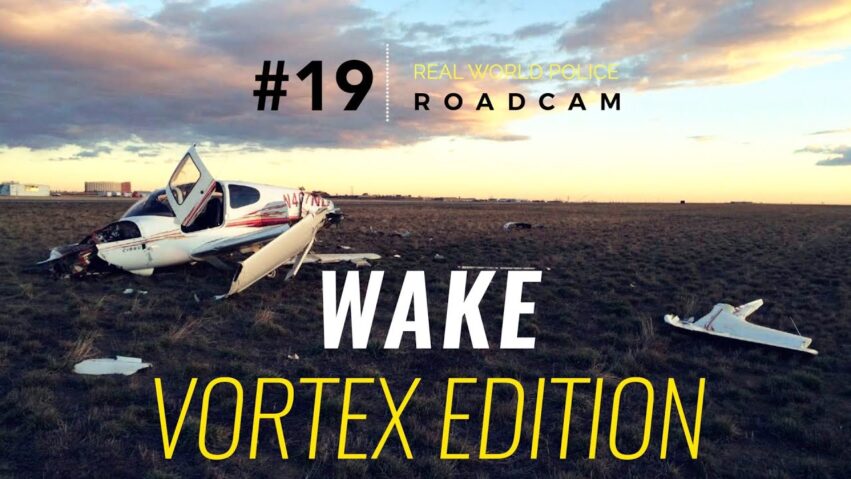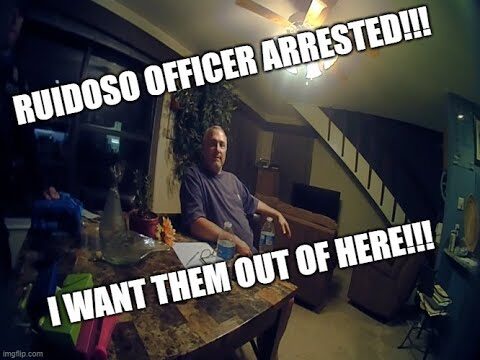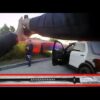Something a bit different. On December 5, 2014, about 1428 MST, a Cirrus SR20 airplane, N407ND, impacted terrain during approach at the Fort Collins-Loveland Municipal Airport (“FNL”), near Fort Collins, Colorado. The solo student pilot was seriously (though not life-threateningly) injured and the aircraft was substantially damaged. Day visual conditions prevailed for the local flight, which departed without a flight plan.
The student pilot stated that he entered the traffic pattern at FNL for a full stop landing on runway 33. He observed a Sikorsky UH-60 helicopter on downwind and delayed his turn to base until the helicopter was on final, abeam his position. While on final, he adjusted his aim point to land long, as he was concerned with wake turbulence and wanted to land beyond the helicopter’s touchdown point. Just prior to landing, he encountered turbulent air, entered into an uncommanded steep left bank, and attempted to go around. The pilot was unable to maintain control and the airplane subsequently impacted terrain and cartwheeled, which resulted in damage to the fuselage and both wings.
AmSafe airbag seatbelt assemblies were mounted in the two front crew seats of the accident aircraft. Neither of the two airbag seatbelts deployed as the airplane cartwheeled. On January 6, 2015, a wreckage review was conducted, which included examination of the crew seats and airbag seatbelt assemblies. A review of data downloaded from the Primary Flight Display (PFD) revealed that longitudinal G-forces necessary to trigger the EMA crash sensors did not occur during the accident sequence. (Which is good, because there was also a hole in one of the inflator tubes.)
In February 1996, the Federal Aviation Administration (FAA) Technical Center released a flight test report (DOT/FAA/CT-94/117) on the hazards of rotorcraft wake vortices in forward flight. The flight test utilized a laser Doppler velocimeter (LDV) to measure helicopter wake vortices. Four helicopters, with weights ranging from 7,600 to 70,000 pounds, were utilized as the wake vortex generating aircraft. The maximum duration for vortex life, as measured by the LDV, was 75 seconds for the UH-60. The FAA flight test report made the following conclusions:
–Medium weight helicopters, such as the S-76A and UH-1….can leave active, potentially hazardous vortices for up to 90 seconds. Separations for small aircraft behind these rotorcraft should therefore be in the 90-second range.
–Larger helicopters, such as the CH-47D and CH-53E ….were observed to have longer hazard times. A 120-second separation should be adequate for operations behind these rotorcraft.
–Information on the wake vortex hazard behind these rotorcraft, including delineation by class, should be included in the Airman’s Information Manual and the Wake Vortex Advisory Circular.
Current (like, today) FAA airman information manual and advisory circular 90-23G on aircraft wake turbulence *do not recommend* an in-trail distance or timing separation for an airplane following a helicopter. The AC contains a general wake turbulence statement: “pilots should avoid helicopter vortices since helicopter forward flight airspeeds are often very low, which generate strong wake turbulence.”
The NTSB found the probable causes of this accident to be the student pilot’s failure to comprehend the significance of the wake turbulence that a preceding helicopter would generate during departure. Contributing was the lack of FAA wake turbulence separation criteria for a small airplane following a helicopter.
~~~
New to the Roadcam series and wondering how it came about? Here’s the scoop:
In this channel’s never-ending pursuit of the absolute best police videos, we often come across footage such as you see in this video — typically held by the police department that investigated the incident or accident, although sometimes acquired through other avenues – like here.
A couple of months ago I shared a sort-of-similar video with Patreon supporters and asked whether they thought the video belonged on Real World Police. Their unanimous and likely-correct answer was “no.” At least not without context sufficient to show the video’s nexus with the channel’s purpose.
But one of the messages I got alongside that was something like: “But, y’know… we wouldn’t mind seeing it here!”
And thus the Roadcam supporter-series was born. Today, one month later, we are hitting twenty episodes. And despite the fact that I have stretched the word “road” far beyond anything Webster might have imagined, I haven’t been hearing complaints.
This is Roadcam #19.
~~~
Like this video and want to see more? You can make that happen! The Roadcam series is one of the many rewards for Real World Police supporters on Patreon. Become a supporter today!
http://www.patreon.com/realworldpolice
Prefer PayPal?
http://paypal.me/realworldpolice
Prefer nothing?
That’s totally fine. You will still get occasional teasers like this one.
** (Disclaimer: This video content is intended for educational and informational purposes only) **






















I gotta call bullshit
While going to take off power probably made it worse. I think just about anyone would've made the mistakes shown here. Glad I learned this today.
AIM chapter 7 section 3. Basic ground school stuff. But he learned the hard way.
If this was a controlled or towered airfield the ground ATC shares some responsibility.
You would never mix a light aircraft so soon.
" CAUTION WAKE TURBULENCE "
Means Just That….
Min 4 Mile separation is REQUIRED….. Case in Point is This Video…. it WILL ROCK YOUR WORLD….
Ouch! Not just heavies you have to be wary of.
I remember seeing this video a while ago. Wake turbulence is no joke
Airport traffic pattern is 6,000 feet Above Ground Level (AGL) or did he mean MSL @ 2:20?
You know what bothers me the most about this entire incident?
When the student pilot wrote his incident report he meant to use the word "AND" but instead like I've seen much too often used the word "AN" I have no idea why this bothers me so much. I also see people mixing up the words "DEAL" and "IDEAL" OK OK…I'm a little bit of a grammar nazi. I'm sorry.
Well I guess he needs a few more lessons
I don’t think it should’ve been the student pilots fault, wake turbulence times for helicopters are not a common knowledge thing for pilots. Instead I would put the blame on ATC for approving the landing
When in doubt, “go aroundâ€
After seeing the wreckage I don’t know how the hell he survived! Poor guy I wonder if he flew again?
Wow. I'm surprised the vortex stayed so long after the black hawk passed.
An excellent written report of the incident. NTSB should offer him a job. Great video/story.
i'm a helicopter pilot. taking off and landing vertically is more dangerous than landing similarly to a plane. however, pilots know how and if conditions permit, it's not anything especially dangerous. taking off and landing vertically require maximum power and depending on conditions and weight, not always possible. if it's busy airspace, it's not always safe or practical for atc to put you direct in or out and they'll make you use a departure or approach including patterns to the runway
Up here where I fly we get the med-evac helios. We always wait 2 minutes to be on the safe side
The Goonzquad boys can fix it
This is the wrong channel. I expect these videos on VASAviation.
Показать реально нечего…Ждём что одобрит ГоÑдеп 🙂 Под видом-Дерьмократии и Свободы.
Just glad no one got killed. Planes can be replaced.
1 hour as Pilot in Command
wow thats what i call a bad start…
I had no idea helicopter wakes could persist that long
I wonder if the crew painted a kill mark on the Blackhawk.
Sounds like we forgot to read about vortex wake and rotor turbulence in the class room. But I believe theres another issue here…
That discussion doesn't belong on frequency. Particularly dont tell people what they should do and dont imply that "it's all good". That creates an expectation bias. Which, in addition to improper training, lead to this outcome.
This is more a rant to you weekend warriors out there chatting each other up on frequency. Stop, you are directly creating a hazardous environment. If you know the regs, have read the AIM, AND FOLLOW THEM then everything will be rock solid. Talk about your kids, pool, and the giant shit you took later when you aren't cruising thru the air at 150 mph.
And here I dread passing a semi on the interstate just because of the lil shaking that happens …
where was the Blackhawk helicopter?
Why does a helicopter have to use the runway. I thought they could take off straight up
Great video to show my students. Thanks
Thanks for adding the test they conducted, very interesting
This incident was not caused by the vortex. The plane was 15 seconds behind and the wind direction was downwind. It was the student mistake.
1
I have a question. Were can I get body cam footage? and footage like this.